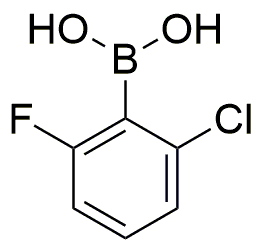2-Chloro-6-fluorophenylboronic acid is widely utilized in research focused on:
- Pharmaceutical Development: This compound serves as a crucial building block in the synthesis of various pharmaceuticals, particularly in the development of targeted therapies for cancer and other diseases.
- Organic Synthesis: It is employed in cross-coupling reactions, such as Suzuki-Miyaura coupling, which allows for the formation of carbon-carbon bonds, essential in creating complex organic molecules.
- Material Science: The compound is used in the development of advanced materials, including polymers and nanomaterials, enhancing properties like conductivity and strength.
- Diagnostics: It plays a role in the design of diagnostic agents, particularly in imaging techniques that help in the early detection of diseases.
- Research in Agrochemicals: This chemical is explored for its potential in developing new agrochemical products, improving crop protection and yield.
General Information
Properties
Safety and Regulations
Applications
2-Chloro-6-fluorophenylboronic acid is widely utilized in research focused on:
- Pharmaceutical Development: This compound serves as a crucial building block in the synthesis of various pharmaceuticals, particularly in the development of targeted therapies for cancer and other diseases.
- Organic Synthesis: It is employed in cross-coupling reactions, such as Suzuki-Miyaura coupling, which allows for the formation of carbon-carbon bonds, essential in creating complex organic molecules.
- Material Science: The compound is used in the development of advanced materials, including polymers and nanomaterials, enhancing properties like conductivity and strength.
- Diagnostics: It plays a role in the design of diagnostic agents, particularly in imaging techniques that help in the early detection of diseases.
- Research in Agrochemicals: This chemical is explored for its potential in developing new agrochemical products, improving crop protection and yield.
Documents
Safety Data Sheets (SDS)
The SDS provides comprehensive safety information on handling, storage, and disposal of the product.
Product Specification (PS)
The PS provides a comprehensive breakdown of the product’s properties, including chemical composition, physical state, purity, and storage requirements. It also details acceptable quality ranges and the product's intended applications.
Certificates of Analysis (COA)
Search for Certificates of Analysis (COA) by entering the products Lot Number. Lot and Batch Numbers can be found on a product’s label following the words ‘Lot’ or ‘Batch’.
Número de catálogo
Número de lote/lote
Certificates Of Origin (COO)
This COO confirms the country where the product was manufactured, and also details the materials and components used in it and whether it is derived from natural, synthetic, or other specific sources. This certificate may be required for customs, trade, and regulatory compliance.
Número de catálogo
Número de lote/lote
Safety Data Sheets (SDS)
The SDS provides comprehensive safety information on handling, storage, and disposal of the product.
DownloadProduct Specification (PS)
The PS provides a comprehensive breakdown of the product’s properties, including chemical composition, physical state, purity, and storage requirements. It also details acceptable quality ranges and the product's intended applications.
DownloadCertificates of Analysis (COA)
Search for Certificates of Analysis (COA) by entering the products Lot Number. Lot and Batch Numbers can be found on a product’s label following the words ‘Lot’ or ‘Batch’.
Número de catálogo
Número de lote/lote
Certificates Of Origin (COO)
This COO confirms the country where the product was manufactured, and also details the materials and components used in it and whether it is derived from natural, synthetic, or other specific sources. This certificate may be required for customs, trade, and regulatory compliance.


